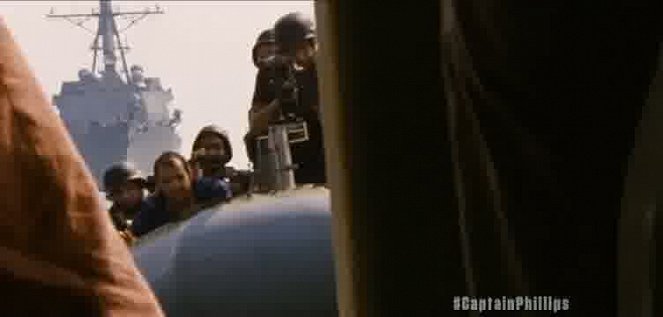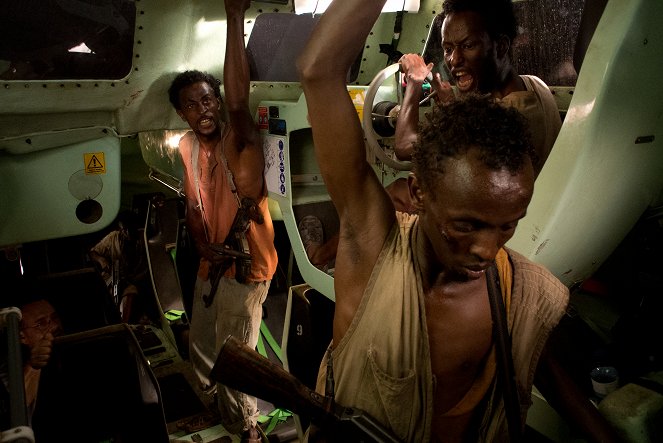Directed by:
Paul GreengrassScreenplay:
Billy RayCinematography:
Barry AckroydComposer:
Henry JackmanCast:
Tom Hanks, Catherine Keener, Barkhad Abdi, Barkhad Abdirahman, Faysal Ahmed, Mahat M. Ali, Michael Chernus, David Warshofsky, Corey Johnson, Chris Mulkey (more)VOD (4)
Plots(1)
Captain Phillips is director Paul Greengrass's multi-layered examination of the 2009 hijacking of the U.S. container ship Maersk Alabama by a crew of Somali pirates. It is – through Greengrass's distinctive lens – simultaneously a pulse-pounding thriller and a complex portrait of the myriad effects of globalization. The film focuses on the relationship between the Alabama's commanding officer, Captain Richard Phillips (Tom Hanks), and his Somali counterpart, Muse (Barkhad Abdi). Set on an incontrovertible collision course off the coast of Somalia, both men will find themselves paying the human toll for economic forces outside of their control. (official distributor synopsis)
(more)Videos (7)
Reviews (15)
If you are afraid that Greengrass' shaky camera and grainy image will be missing, be calm, it's here again and there's plenty of it. Moreover, no one can do an ad for the US Navy as sophisticatedly and inconspicuously as him. And Tom Hanks is also excellent. It doesn't have the momentum of United 93 (greater fatefulness) or the Bourne films (a more attractive, action-packed theme), but it's still an original film, full of gripping moments and excellently acted scenes.
()
It’s hard to praise this type of movie better than saying that the creators make it hard for the viewer even to catch their breath for all the suspense here. Despite the fact that they already know not only the result, but (probably) even how the action is going to pan out. The whole thing is underpinned by an unusually powerful final scene in the treatment room which is deserving of all the actors awards in existence.
()
“We all got bosses.” Concerns that, unlike the unaffected Danish film A Hijacking, this would be a heroic drama were fulfilled by Greengrass’s Captain Phillips to a much lesser extent than I had feared. Yes, instead of an ordinary employee, the (moral) focal point of the narrative is a conscientious American in an important position and, what’s more, portrayed by an actor whose name is synonymous with the word “credibility”. However, Phillips realistically prioritises his own survival over dressing himself up as a hero, as evidenced especially in the climax with its non-Hollywood rawness, which is the final demonstration of the emphasis that the film places on the intensity of visceral experience. The expression of concern for Phillips’s wife (the considerably underused Catherine Keener) in a less emotive written form is a twice utilised method of “desentimentalisation”. ___ Whereas in A Hijacking Lindholm never loses sight of the socio-cultural context and sees the development of the events as a consequence of the uncompromising application of corporate logic, Greengrass sets aside the broader context after the beginning and uses the situation to focus particularly on strong emotions instead of the clash of cultures and classes (and generations). Nevertheless, he amplifies his criticism of inequality during the second half by expanding the point of view of the narrative, which had previously been limited to the two captains, to include that of the all-seeing American military. The shots of seamen exhibit cool professionalism in striking contrast to the “DIY” methods of both the pirates and the crew of Phillips’s ship. ___ Captain Phillips is political also in following the trend of contemporary genre movies consisting in depicting an individual having to rely on himself. The protagonist is gradually stripped of all privileges of civilisation and nearly all of his possessions (including his clothes) and, through his manoeuvring, finds himself at the same level as the pirates. A certain political nature can also be seen in the attempt at a balanced view of the causes leading to the actions of either side of the conflict. From the opening minutes, parallels are drawn between the lives and livelihoods of Phillips and the pirates. Like Phillips, the pirates want only to do their jobs, make money and get back home. Because the division of roles into prey and victim is not fixed, those roles can be reversed in the second half of the film. The inconsistency of this avoidance of a black-and-white view of reality becomes apparent when more closely watching the camerawork. The point-of-view shots belong exclusively to Phillips. By comparison, the protagonist is filmed with shots that are neutral in terms of perspective and seemingly don’t belong to anyone. In other words, the pirates do not have control over the image. ___ Regardless of the ideological implications, Captain Phillips is a particularly flawlessly rhythmised drama with twists delivered at roughly twenty-minute intervals and a rapidly approaching ending, thanks to which the narrative is gripping, even if you know the actual true story in advance. The essential twist and the broadening of awareness connected with it come after an hour. The sudden change of location serves for more than just making the viewer uncomfortable (“I didn’t expect that”). It also comments on the development of the position held by the main character, who gradually and literally loses the ground beneath his feet (due to the setting, the final phase of this destabilisation is more than obvious). ___ As in Gravity, an individual becomes a lightning rod for many of the problems troubling today’s society, though Greengrass takes that individual’s transformation in a different direction than Cuarón did. In this case, the film is an uneasy (in style) and disturbing (in emotion) response to an uncertain time, paradoxically thanks mainly to the fact that someone thought long and calmly about how to make it. 85%
()
(less)
(more)
A superb dramatization and high-octane exhibition of filmmaking adrenaline that once again elevates pseudo-documentary realistic authenticity to a full-blown blockbuster experience. Although Greengrass goes about this unlike anyone from the numerous rows of his many "copy & paste" colleagues, it's a bit of a safe bet on his part, with the camera looking over his shoulder and whizzing between faces just long enough for you to know who he's thinking of. It's not boring at all, but it does last about fifteen minutes longer than audiences would like. Then it would be a fuller experience. And let's face it, when was the last time you saw a Navy SEALS presentation this short and impactful? PS: Hans Zimmer is thanked in the credits, but as the central motif unfolded, I kept subconsciously waiting for the black hood to appear. 4 ½.
()
Is Captain Phillips a glorification of the status quo and a civilian hero? I don’t think so. A comparison with Lindholm's A Hijacking is entirely relevant, but we should not automatically claim that the Danish "harder, colder, and non-hero" interpretation of reality is "better". A material comparison of starting points is interesting: The Danes choose a typical situation, whilst the Americans a dramatic and spiraling situation. The protagonist of A Hijacking is an ordinary sailor who is a passive "commodity" in negotiations, the hero of Greengrass's film is already picked up and belongs to the active movers (he is a captain and actively fights for his life almost to the last moment). The American version is actually two-thirds characterized by shifts, actions and reversals, while the Danish version completely avoids them and captures the routine of negotiations that drag on callously. The Danes film in the affected area and let the whole crew live in uncertainty (because they also want to transfer the rawness to the film), whereas the Americans use the calm waters around Malta. These are two approaches to the same topic, I see no reason to hierarchize them - both are completely legitimate. In addition, they both create a very similar picture: a broken individual and a system that continues to function as if nothing had happened. We can certainly perceive Captain Phillips as a celebration of the Navy Seals and the US Army, but Greengrass gives enough clues to the counter-interpretation - the whole situation is absurd, disproportionate and unsolvable (a small orange boat vs. three warships), and both sides happen to have legitimacy. The fact that he is monitoring Phillips and his future captor in parallel should alert us that Greengrass wants to do more than just paint a thrilling case. Similarly to Zero Dark Thirty, here, it is as if more clues seem to tempt to the conventional satisfaction that the disgusting skinny people will get their assess kicked, yet the action only provides spectator satisfaction to a limited extent. There is a disturbing array of free motifs that Greengrass surrounds with his millimeter-accurate direction. My view is more in line with Lindholm's, but that doesn't mean Captain Phillips didn't get to me in the end. It only happened during the penultimate scene, but it was worth the wait. [80%]
()



Ads